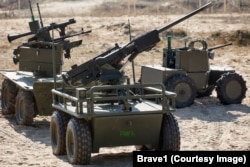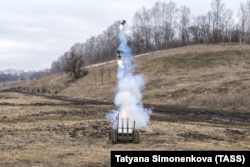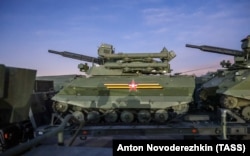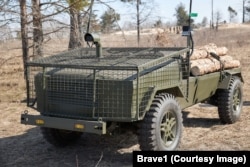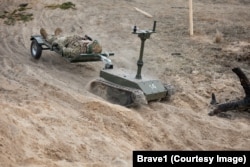The modern battlefield has been transformed by drones in the air and on the high seas, and now both Russia and Kyiv appear to be on the cusp of deploying large numbers of ground drones onto Ukrainian soil.
A recent video captures the degree to which unmanned vehicles are transforming the modern battlefield. The clip shows two tracked Russian ground drones armed with grenade launchers being destroyed by Ukrainian aerial drones, all of which is captured by a reconnaissance drone hovering nearby.
The drone-on-drone destruction is one of several visuals released in recent weeks featuring unmanned ground vehicles (UGVs). Other clips feature a ground drone firing volleys of tracer bullets at a Russian position, and a wheeled kamikaze drone trundling a massive explosive device across open ground before detonating under a bridge in Russian-held territory.
Nataliia Kushnerska, the head of Brave1, a Ukrainian government organization that helps to steer private inventions toward adoption by the country's military, told RFE/RL her organization had "made the development of ground robots one of its top priorities to catch up with other unmanned systems."
Brave1, she says, has had more than 200 UGV designs submitted to their platform, and has tested 50 so far.
Ground drones were first used in combat by the U.S.S.R. during its invasion of Finland in 1939. The Soviet "teletanks" were conventional tanks equipped with a radio control system. The vehicles were limited by the human controllers needing to steer the vehicle and aim its weapons from a distance without the aid of modern video feeds. Soviet teletanks were reportedly last used in combat in 1942 during World War II.
Also during the war, the German military built a kamikaze ground drone dubbed the Goliath. The bumper-car-sized vehicle was loaded with explosives and controlled through a wire that trailed behind as the Goliath made its way toward enemy positions. Thousands of the "demolition drones" were produced, but they proved slow and cumbersome and were easily stopped by gunfire.
Since World War II, multiple attempts have been made to revive the concept of the combat ground drone, with limited success. Russia's Uran-9 unmanned tank was used in combat during Syria's civil war in 2018 but reportedly fared so poorly that an officer noted the system was at least a decade away from being ready for battle. The vehicle has not yet been deployed in Ukraine.
Michael Boyle, an associate professor at Rutgers University and author of a book on drone warfare, told RFE/RL there are several reasons combat ground drones have been slow to develop.
"The first is terrain," he said. While aerial drones can generally fly as freely as birds and marine drones also move through a relatively unconstrained element, ground drones "need to be able to move rapidly over uneven surfaces to complete their task and do so under fire in contested regions," Boyle says.
Obstacles as simple as a ditch, or coils of barbed wire that a soldier could easily hop over, present an impassable barrier for many ground drones.
Another key factor is cost.
"Developing a ground vehicle that can operate over uneven terrain remotely, and be integrated with other military units, is expensive," Boyle said.
While kamikaze aerial drones costing a few hundred dollars are routinely sent on one-way missions, ground drones large and advanced enough to navigate pockmarked battlefields "are generally not disposable in the same way," Boyle said.
The drone expert added that "communications infrastructure with [ground drones] must be especially secure, at least for now while they remain so expensive, and that presents its own barrier to entry."
Kushnerska says the most promising of the ground-drone designs Brave1 is testing is currently a vehicle designed to transport wounded from the battlefield.
"Communication with the military has shown us that the defenders suffer many of their losses during the evacuation of the wounded," she says.
She says a remotely controlled or autonomous vehicle could take the place of the three to six soldiers needed to carry a wounded soldier away from the front lines.
"By the end of 2024, we expect this [evacuation] UGV will become a systematic part of our military's actions," she predicted.
